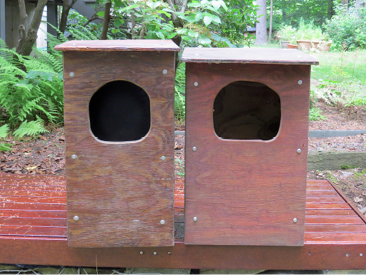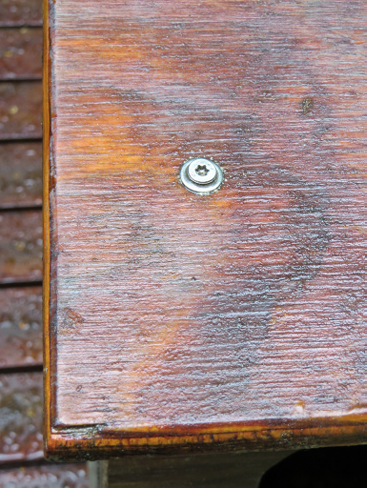Alfred Maley

Fig 1. Tight Fit for Barred Owlets All photographs by the author.
Experience is the best teacher. While the original design described in Bird Observer (Maley 2010, 2015) is good, field experience has shown ways to make it even better.
Seeing an older sibling ejecting a younger sibling from the entrance hole has suggested an eight-inch wide hole to prevent that. Two owlets can be comfortable with that width.

Fig. 2. Old Model, New Model.
Anecdotal evidence from European owl box builders has suggested that wider boxes are better than deeper or even square ones. That's because younger owlets have a better chance of being fed if they are side by side with their siblings rather than at the end of a queue (Figure 1). Accordingly, the box width is now 15 inches instead of 13 inches. To keep the weight down, the box height has been decreased from 24 inches to 23 inches (Figure 2). I had succumbed to making the boxes two feet tall, using a four-foot-wide piece of plywood without any "waste."
"Plywood ain't what it used to be." I have boxes that are 30 years old that are as good as the day they were made. I also have new boxes that delaminated within three years, causing box failure. It may be the glue, but more likely it is the number of voids in the interior layers of the plywood that allow water to penetrate and cause havoc. To prevent delamination I've taken to sealing the voids and then the entire edge with epoxy. Before doing so, I pass the edges of the roof and front and back over a router with a rounding over bit. This not only smooths the corners, it also exposes the small voids that might be hard to detect otherwise. I use either two-part epoxy glue (Weld) or wood consolidant (www.abatron.com).

Fig. 3. Sealed Edge Fastener.
The last improvement has to do with how to fasten the plywood to the balusters that form the interior battens of the nest box, giving it strength and form. Originally I screwed #8 1–5/8" stainless steel deck screws into the plywood and the baluster. But sometimes the plywood would splinter, even if I predrilled the hole. So I beveled each hole to accept the screw head, but then I found that the screws would sometimes penetrate the battens and I would have to file the tips off to protect the box occupants.
I then realized that I could use a #10 stainless steel washer on each screw that would solve all these problems (Figure 3).
References
- Maley, A. 2010. Low-Maintenance Barred Owl Nest Boxes. Bird Observer 38: 151–155.
- Maley, A. 2015. Barred Owl Adventures in Hampstead. Bird Observer 43: 294–298.
Alfred Maley is a retired software engineer whose interest in nest boxes began at age 10, when he cobbled together a successful bluebird house with wood from an orange crate. Later came Barn Owl nest boxes and Long-eared Owl nest baskets. When they are not watching raptor migration in Spain or traveling with Danger Tours to Latin America, he and his wife Linda reside in Hampstead, New Hampshire. Al can be reached at alfredmaley@gmail.com.